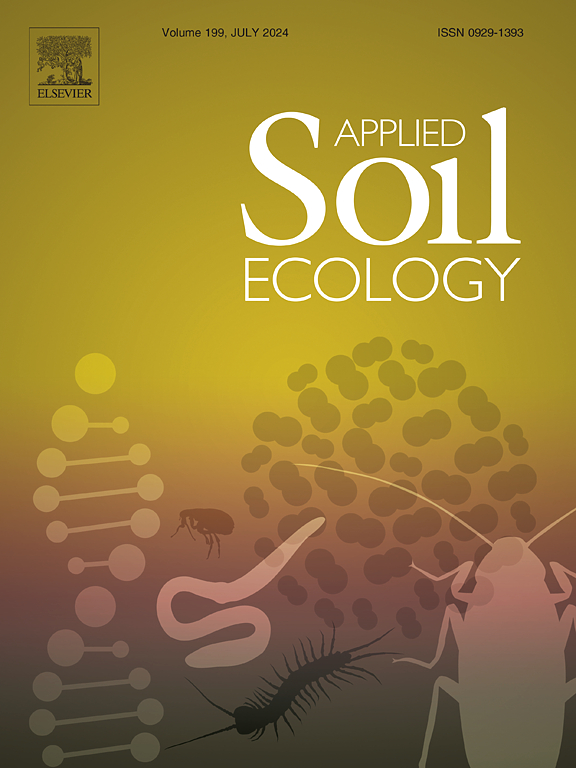Microbial drivers of soil C:N:P stoichiometry dynamics during ecological restoration in sandy ecosystems
IF 4.8
2区 农林科学
Q1 SOIL SCIENCE
引用次数: 0
Abstract
Soil microbes drive plant diversity and productivity in terrestrial ecosystems and are directly involved in plant nutrient acquisition and soil nutrient cycling. However, the microbiological mechanisms of soil organic carbon (SOC), total nitrogen (TN), and total phosphorus (TP) stoichiometry during vegetation restoration in sandy land remain unclear. This study investigated the ecological stoichiometric characteristics of SOC, TN, and TP in semi-arid degraded sandy land and the underlying mechanisms using space for time substitution for sites in different stages of vegetation restoration: mobile dunes (MD), semi-mobile dunes (SMD), semi-fixed dunes (SFD), fixed dunes (FD), and sparse forest grassland (SFG). SOC, TN, and TP contents increased significantly with restoration of sandy vegetation, indicating a gradual improvement in soil quality. The increase of SOC:TP and TN:TP with vegetation restoration indicated that the accumulation rate of carbon and nitrogen was faster than that of phosphorus, and phosphorus became a key limiting element after vegetation restoration. Decreased SOC:TN indicated accelerated organic matter decomposition and enhanced nitrogen mineralization. In the MD and SMD stages, carbon, nitrogen and phosphorus lacked stable organic carriers (such as humus), resulting in no significant correlation between SOC, TN and TP contents. However, with the restoration of vegetation in sandy land, the significant correlation between SOC and TN was enhanced, and the correlation between TN and TP was stronger than that between SOC and TN, SOC and TP. The enhancement of extracellular enzyme activities driven by precipitation prompted a succession of microbial communities from copiotrophic (dominated by Ascomycetes) to oligotrophic (dominated by Acidobacteria) during vegetation restoration in sandy land. We found that vegetation restoration and precipitation shape nutrient dynamics via their influence on microbial and extracellular activity. This has important implications for developing effective strategies to mitigate desertification and its impact on global ecosystems.
沙质生态系统生态恢复过程中土壤C:N:P化学计量动力学的微生物驱动因子
土壤微生物驱动陆地生态系统植物多样性和生产力,并直接参与植物养分获取和土壤养分循环。然而,沙地植被恢复过程中土壤有机碳(SOC)、全氮(TN)和全磷(TP)化学计量的微生物机制尚不清楚。研究了半干旱退化沙地土壤有机碳(SOC)、全氮(TN)和总磷(TP)的生态化学计量学特征,以及在不同植被恢复阶段:流动沙丘(MD)、半流动沙丘(SMD)、半固定沙丘(SFD)、固定沙丘(FD)和疏林草地(SFG)的立地空间替代机制。随着沙质植被的恢复,土壤有机碳、全氮和全磷含量显著增加,表明土壤质量逐渐改善。土壤有机碳:总磷和全氮:总磷随植被恢复而增加,说明植被恢复后碳、氮的积累速度快于磷的积累速度,磷成为植被恢复后的关键限制元素。SOC:TN降低表明有机质分解加快,氮矿化增强。在MD和SMD阶段,碳、氮、磷缺乏稳定的有机载体(如腐殖质),导致有机碳、全氮和全磷含量之间的相关性不显著。但随着沙地植被的恢复,土壤有机碳与全氮的显著相关性增强,全氮与总磷的相关性强于土壤有机碳与全氮、有机碳与总磷的相关性。降水驱动胞外酶活性增强,促使沙地植被恢复过程中微生物群落由嗜养型(以子囊菌为主)向寡养型(以酸杆菌为主)演替。我们发现植被恢复和降水通过对微生物和细胞外活动的影响来塑造养分动态。这对制定有效战略减轻荒漠化及其对全球生态系统的影响具有重要意义。
本文章由计算机程序翻译,如有差异,请以英文原文为准。
求助全文
约1分钟内获得全文
求助全文
来源期刊

Applied Soil Ecology
农林科学-土壤科学
CiteScore
9.70
自引率
4.20%
发文量
363
审稿时长
5.3 months
期刊介绍:
Applied Soil Ecology addresses the role of soil organisms and their interactions in relation to: sustainability and productivity, nutrient cycling and other soil processes, the maintenance of soil functions, the impact of human activities on soil ecosystems and bio(techno)logical control of soil-inhabiting pests, diseases and weeds.
 求助内容:
求助内容: 应助结果提醒方式:
应助结果提醒方式:


